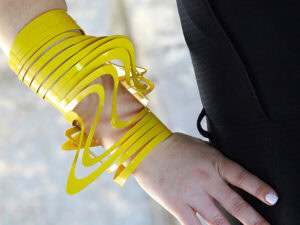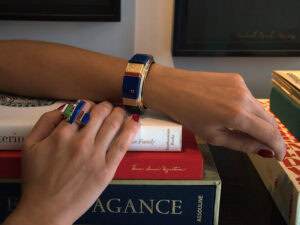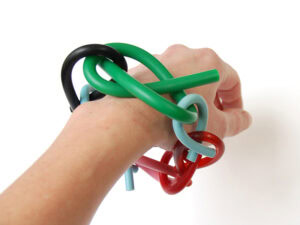The overwhelming success of Alexander McQueen: Savage Beauty, an exhibition of the late fashion designer’s work at the Metropolitan Museum of Art this past summer, was a stark proclamation of the influence that fantastical body adornment has over the public imagination. In just over three months the MET saw over 650,000 visitors to the exhibition and sold over 100,000 copies of the catalog. (For further reading see Rebecca Annand’s AJF review ‘McQueen in Manhattan.’) Certainly, contributing to the success of the exhibition was McQueen’s premature passing and controversial flair, but if further evidence is required of our fixation with fantastical fashion, one need look no further than the meteoric rise of pop icon Lady Gaga. In their own highly competitive spheres of influence these artists distinguished themselves by constructing an alternative and highly personal version of reality through dress. We, the audience, are transported. The authenticity of this grandeur is somewhat suspect because sincerity and pop music (or runway fashion) are oil and water. Despite genre stereotypes it is through spectacle of personality and media savvy that McQueen and Gaga have been lionized as genuine. Sadly, in the world of art jewelry the ability to project oneself as a celebrity is severely undermined by the marginal cultural role of the field – although this doesn’t stop Ruudt Peters, Ted Noten, Robert Baines or Karl Fritsch. However the commitment to constructing a fantastical personal reality through jewelry and accessories is something that several young makers are doing quite convincingly.
Charlotte Daffern is a United Kingdom-based jewelry, fashion and accessory designer whose work willfully defies categorization. Many of her amorphous and animalistic works are worn on the wrist or neck. With leg-of-mutton sleeves (popular c.1890), plaid fabrics, leather buckles and pearls, Daffern creates formal and material references that evoke a romantic nationalism, an inquiry shared by fellow Brit, Alexander McQueen. Beyond merely creating historical footnotes, Daffern’s output suggests a multivalent engagement with both personal and cultural identity. The work reflects Daffern’s conception of ‘Britishness’ albeit obfuscated by playful zoomorphism and raw adolescent sexuality. The cultural entry points allow the viewer to project him or herself into Daffern’s personal fantasy. In Daffern’s Acid Housewife series (2009-10) she combines notions of personal and cultural identity in wearable sculptural works addressing herself to mid-twentieth century gender stereotypes, albeit in an ironic hyper-sexualized format. While Daffern’s work undoubtedly participates in an art jewelry modality, the photographic rendition of the work reveals Daffern’s fashion sympathies. Most viewers will experience the work as an image and it is the photographic contextualization that situates the work as an haute couture accessory as well as the product of a studio-based jewelry practice.
For Natalya Pinchuk photographic context also plays a large role in the locating her large, fantastical fiber-based work. Through documentation Pinchuk resolutely locates her Peacock and Booster series (2006-2008) in everyday life and mundane locales, but this only serves to make blatant the sexually suggestive other-worldliness of the work. The sculptural felted neckpieces and ‘pocket brooches’ have colorful, botanical and monster qualities, as if freed from the pages of Dr. Seuss or Lewis Carroll. The overt sexual references to lobes, phalluses and thick curly fibers endow the work with a certain vulgar humor – perhaps as if Seuss wrote adult books. Pinchuk’s work explores the margins of natural male sexuality, and not the testosterone-induced cultural image of men as gladiators, but a softer, more sensual male sexuality. The textile-based format of Pinchuk’s work, along with its sexual content, ties it to other jewelers working in the sub-genre that she occupies, but also locates it in proximity to fashion. Its cumbersome, unwieldy nature reads as haute couture accessory. Pinchuk is clearly more concerned with the image of the work than any gesture towards function or wearability. Her fantastic vision disrupts easy social interaction, pointing out our ashamedness of male sexuality in a vernacular context and thereby suggesting the appropriate placement of the work is, in fact, deep within Pinchuk’s personal realm. While she denies the importance of her husband as the frequent model, her idiosyncratic forms and intimate subject give us a window into her work’s highly personal nature.
And while Pinchuk’s Peacock and Booster series are an honest engagement with male sexuality, the emotive power and gothic romanticism of Joe Churchman’s Ridiculous Ruffs are rooted in a protracted technical engagement with foamed neoprene. Developed as an industrial material, Churchman masterfully embraces the material’s aesthetic and physical qualities, rendering it a stiff textile and constructing neck and arm pieces with joinery appropriated from the world of jewelry and woodworking. Whatever Churchman’s impetus, the work is distinctive in personality. While much outsized wearable work created in recent years is imaginative, Churchman’s work is set apart by its darkness. Color – or absence of color – obviously contributes to the gloom, but the intricate forms also enhance a feeling of uncanny gothic macabre. This is quite a feat of accomplishment in such large and playful accessories. The black color, restrictive locations, and exaggerated appendages of Churchman’s Ridiculous Ruffs also give the work an empowering sexuality that subtly references S&M, but this is balanced by elegant sixteenth and nineteenth century historical footnotes that allow the work to rise above a merely fetishistic reading. Both Elizabethan (the era of the Virgin Queen) and Victorian Britain were quite chaste and conservative historical periods. In combining these influences Churchman has created an interesting internal tension. However large and unapologetically cumbersome the works are, they exists on a scale that is logical and proclamatory. Churchman creates statement pieces that spring from his personal engagement with material, and manifest on an imaginary plane as costume or accessory – appropriate for a fantastical wearer. The works feel like they would be at home at Comic-Con as much as they would be on the runway.
Rachel Timmins also explores the fertile territory of large wearable fantastical work. Timmins’s work often augments, or is supplemental to, the body, acting more like costume than fashion. But similarly to other aforementioned works, Timmins creates a highly personal fantasy realm where the work is located. Perhaps it would be more accurate to say that Timmins creates fantastical props that can be used to engage the real world, in a way, not so dissimilar from Pinchuk. Tiny, a pale-green modular bodysuit with a bright-red glitter spewing cherry on top, was road tested and documented in a video where Timmins let loose her creations in the real world; on the street, in parks and at retail stores. This sort of fantastical interventionism shares its ethos with works by Nick Cave and Erwin Worm, though the form language of the work has more in common with the whimsy of Claes Oldenburg or Ernesto Netto. Timmins’s Growth One, a one-and-a-half foot sparkling red teardrop, has a hole in the top that covers any probe in profane red glitter. It is a sexually explicit allegory. Timmins’s work challenges and activates the body, making it a site for physical and sexual inquiry. All the while, this is articulated through a dense personal language of colorful spandex, resin, automotive paint and glitter.
In the work of Daffern, Pinchuk, Churchman and Timmins there is clearly a highly evolved formal language native to each artist. Unsurprisingly, different imaginations yield different figments. In distinctly different ways then, these artists give form to their fantasies. What is curious is that each artist has executed his or her work on a scale that subjugates the body, rendering it merely the site of the accessory. The scale of these works also allows the artists to sublimate the function of the wearable objects in favor of their imaginative and authentic declaration. The predominance of a fantastical form language – that circumvents cultural convention – allows the sexual allusions of this work to be made more palatable, as if by making them imaginary propositions they are detached from reality. Ultimately, these works defy easy categorization existing as sculptural fashion fantasies, individualistic studio-based jewelry and suppressed erotic accessories. In them we find a glimpse of the visionary creative imagination, the one that is universally recognizable as being worthy of our attention. It is that recognition, of authenticity, that seeps into the personality and creativity of the work. While none of these artists is likely to be iconic in the same way as Alexander McQueen or Lady Gaga, it is the common trait of authenticity and imaginative personal vision that warrants our attention.
The overwhelming success of Alexander McQueen: Savage Beauty, an exhibition of the late fashion designer’s work at the Metropolitan Museum of Art this past summer, was a stark proclamation of the influence that fantastical body adornment has over the public imagination. In just over three months the MET saw over 650,000 visitors to the exhibition and sold over 100,000 copies of the catalog. (For further reading see Rebecca Annand’s AJF review ‘McQueen in Manhattan.’) Certainly, contributing to the success of the exhibition was McQueen’s premature passing and controversial flair, but if further evidence is required of our fixation with fantastical fashion, one need look no further than the meteoric rise of pop icon Lady Gaga. In their own highly competitive spheres of influence these artists distinguished themselves by constructing an alternative and highly personal version of reality through dress. We, the audience, are transported. The authenticity of this grandeur is somewhat suspect because sincerity and pop music (or runway fashion) are oil and water. Despite genre stereotypes it is through spectacle of personality and media savvy that McQueen and Gaga have been lionized as genuine. Sadly, in the world of art jewelry the ability to project oneself as a celebrity is severely undermined by the marginal cultural role of the field – although this doesn’t stop Ruudt Peters, Ted Noten, Robert Baines or Karl Fritsch. However the commitment to constructing a fantastical personal reality through jewelry and accessories is something that several young makers are doing quite convincingly.
Charlotte Daffern is a United Kingdom-based jewelry, fashion and accessory designer whose work willfully defies categorization. Many of her amorphous and animalistic works are worn on the wrist or neck. With leg-of-mutton sleeves (popular c.1890), plaid fabrics, leather buckles and pearls, Daffern creates formal and material references that evoke a romantic nationalism, an inquiry shared by fellow Brit, Alexander McQueen. Beyond merely creating historical footnotes, Daffern’s output suggests a multivalent engagement with both personal and cultural identity. The work reflects Daffern’s conception of ‘Britishness’ albeit obfuscated by playful zoomorphism and raw adolescent sexuality. The cultural entry points allow the viewer to project him or herself into Daffern’s personal fantasy. In Daffern’s Acid Housewife series (2009-10) she combines notions of personal and cultural identity in wearable sculptural works addressing herself to mid-twentieth century gender stereotypes, albeit in an ironic hyper-sexualized format. While Daffern’s work undoubtedly participates in an art jewelry modality, the photographic rendition of the work reveals Daffern’s fashion sympathies. Most viewers will experience the work as an image and it is the photographic contextualization that situates the work as an haute couture accessory as well as the product of a studio-based jewelry practice.
For Natalya Pinchuk photographic context also plays a large role in the locating her large, fantastical fiber-based work. Through documentation Pinchuk resolutely locates her Peacock and Booster series (2006-2008) in everyday life and mundane locales, but this only serves to make blatant the sexually suggestive other-worldliness of the work. The sculptural felted neckpieces and ‘pocket brooches’ have colorful, botanical and monster qualities, as if freed from the pages of Dr. Seuss or Lewis Carroll. The overt sexual references to lobes, phalluses and thick curly fibers endow the work with a certain vulgar humor – perhaps as if Seuss wrote adult books. Pinchuk’s work explores the margins of natural male sexuality, and not the testosterone-induced cultural image of men as gladiators, but a softer, more sensual male sexuality. The textile-based format of Pinchuk’s work, along with its sexual content, ties it to other jewelers working in the sub-genre that she occupies, but also locates it in proximity to fashion. Its cumbersome, unwieldy nature reads as haute couture accessory. Pinchuk is clearly more concerned with the image of the work than any gesture towards function or wearability. Her fantastic vision disrupts easy social interaction, pointing out our ashamedness of male sexuality in a vernacular context and thereby suggesting the appropriate placement of the work is, in fact, deep within Pinchuk’s personal realm. While she denies the importance of her husband as the frequent model, her idiosyncratic forms and intimate subject give us a window into her work’s highly personal nature.
And while Pinchuk’s Peacock and Booster series are an honest engagement with male sexuality, the emotive power and gothic romanticism of Joe Churchman’s Ridiculous Ruffs are rooted in a protracted technical engagement with foamed neoprene. Developed as an industrial material, Churchman masterfully embraces the material’s aesthetic and physical qualities, rendering it a stiff textile and constructing neck and arm pieces with joinery appropriated from the world of jewelry and woodworking. Whatever Churchman’s impetus, the work is distinctive in personality. While much outsized wearable work created in recent years is imaginative, Churchman’s work is set apart by its darkness. Color – or absence of color – obviously contributes to the gloom, but the intricate forms also enhance a feeling of uncanny gothic macabre. This is quite a feat of accomplishment in such large and playful accessories. The black color, restrictive locations, and exaggerated appendages of Churchman’s Ridiculous Ruffs also give the work an empowering sexuality that subtly references S&M, but this is balanced by elegant sixteenth and nineteenth century historical footnotes that allow the work to rise above a merely fetishistic reading. Both Elizabethan (the era of the Virgin Queen) and Victorian Britain were quite chaste and conservative historical periods. In combining these influences Churchman has created an interesting internal tension. However large and unapologetically cumbersome the works are, they exists on a scale that is logical and proclamatory. Churchman creates statement pieces that spring from his personal engagement with material, and manifest on an imaginary plane as costume or accessory – appropriate for a fantastical wearer. The works feel like they would be at home at Comic-Con as much as they would be on the runway.
Rachel Timmins also explores the fertile territory of large wearable fantastical work. Timmins’s work often augments, or is supplemental to, the body, acting more like costume than fashion. But similarly to other aforementioned works, Timmins creates a highly personal fantasy realm where the work is located. Perhaps it would be more accurate to say that Timmins creates fantastical props that can be used to engage the real world, in a way, not so dissimilar from Pinchuk. Tiny, a pale-green modular bodysuit with a bright-red glitter spewing cherry on top, was road tested and documented in a video where Timmins let loose her creations in the real world; on the street, in parks and at retail stores. This sort of fantastical interventionism shares its ethos with works by Nick Cave and Erwin Worm, though the form language of the work has more in common with the whimsy of Claes Oldenburg or Ernesto Netto. Timmins’s Growth One, a one-and-a-half foot sparkling red teardrop, has a hole in the top that covers any probe in profane red glitter. It is a sexually explicit allegory. Timmins’s work challenges and activates the body, making it a site for physical and sexual inquiry. All the while, this is articulated through a dense personal language of colorful spandex, resin, automotive paint and glitter.
In the work of Daffern, Pinchuk, Churchman and Timmins there is clearly a highly evolved formal language native to each artist. Unsurprisingly, different imaginations yield different figments. In distinctly different ways then, these artists give form to their fantasies. What is curious is that each artist has executed his or her work on a scale that subjugates the body, rendering it merely the site of the accessory. The scale of these works also allows the artists to sublimate the function of the wearable objects in favor of their imaginative and authentic declaration. The predominance of a fantastical form language – that circumvents cultural convention – allows the sexual allusions of this work to be made more palatable, as if by making them imaginary propositions they are detached from reality. Ultimately, these works defy easy categorization existing as sculptural fashion fantasies, individualistic studio-based jewelry and suppressed erotic accessories. In them we find a glimpse of the visionary creative imagination, the one that is universally recognizable as being worthy of our attention. It is that recognition, of authenticity, that seeps into the personality and creativity of the work. While none of these artists is likely to be iconic in the same way as Alexander McQueen or Lady Gaga, it is the common trait of authenticity and imaginative personal vision that warrants our attention.




